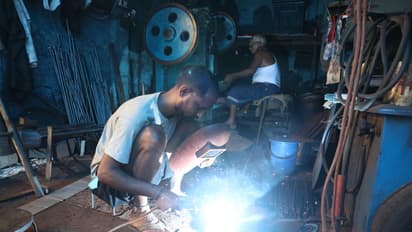India's manufacturing jobs surge by 7.6%, wages rise 5.5%, GVA leaps 21% in FY-23; FM hails comeback

Synopsis
As per a government survey, manufacturing jobs have surged by 7.6%, while wages saw a 5.5% increase, underscoring the country’s impressive economic recovery post-pandemic.
In a significant boost to the Indian economy, Union Finance Minister Nirmala Sitharaman hailed the remarkable rise in manufacturing jobs and wages during the fiscal year 2022-23. As per a government survey, manufacturing jobs have surged by 7.6%, while wages saw a 5.5% increase, underscoring the country’s impressive economic recovery post-pandemic.
“Under the leadership of Prime Minister Narendra Modi, India’s manufacturing sector has not only rebounded but is now thriving,” said Sitharaman, attributing the success to several key government initiatives.
The latest data reveals that employment in India’s manufacturing sector rose from 1.6 crore workers in FY 2018-19 to 1.9 crore workers in FY 2022-23, marking a significant increase. The number of workers employed per factory also grew, rising from 65 to 71 over the same period. This increase reflects a higher concentration of employment within the sector, suggesting that factories are operating at higher capacities and employing more people.
Wages in the manufacturing sector have also seen a substantial rise, with workers now earning an average of Rs 2.05 lakh annually, up from Rs 1.69 lakh in FY 2018-19. This 5.5% wage increase has improved the standard of living for millions of workers, translating into better economic conditions for their families.
India’s Gross Value Added (GVA) in manufacturing, a key indicator of the sector's contribution to the economy, has surged by over 21% between FY 2021-22 and FY 2022-23. This growth highlights the strong performance of the manufacturing sector, which has been a driving force behind the country's economic resurgence.
“The surge in GVA by over 21% is a clear indication that India’s manufacturing sector is firing on all cylinders,” Sitharaman added, pointing to the Modi government’s comprehensive economic policies as a major catalyst for this turnaround.
BJP-ruled states lead manufacturing growth
BJP-ruled states have emerged as powerhouses in driving India’s manufacturing revolution, contributing significantly to the nation’s output and employment. Gujarat, Maharashtra, and Uttar Pradesh have been at the forefront, accounting for a major share of both jobs and industrial output.
Gujarat, renowned for its entrepreneurial spirit, leads with 17.7% of India’s total manufacturing output, followed by Maharashtra, which accounts for 14.6%. Uttar Pradesh, the country’s most populous state, contributed 7.1% to the national manufacturing output.
In terms of employment, Maharashtra leads with 12.8% of the total number of people employed in the sector, followed closely by Gujarat with 12.6% and Uttar Pradesh with 8.1% in FY 2022-23.
When it comes to the number of factories in operation, Gujarat, Maharashtra, and Uttar Pradesh have secured top ranks. Gujarat contributes 12.2% of the total factories in the country, ranking second, followed by Maharashtra with 10.4% (third rank), and Uttar Pradesh with 7.5% (fourth rank). Andhra Pradesh, a National Democratic Alliance (NDA) ally state, holds the fifth spot with 6.5% of the factories.
Together, these states—Gujarat, Maharashtra, Uttar Pradesh, along with Tamil Nadu and Karnataka—form the backbone of India’s manufacturing sector, accounting for over 50% of the nation’s total manufacturing jobs.
Government initiatives driving growth
The Modi government’s Production-Linked Incentive (PLI) Scheme has been instrumental in driving this manufacturing boom. The scheme offers financial incentives to industries across various sectors, including electronics and textiles, which has led to the creation of lakhs of new jobs.
Additionally, the Make in India initiative, which recently marked its 10th anniversary, has revitalized the country’s manufacturing capabilities by boosting domestic production and attracting significant foreign investment. PM Modi’s Aatmanirbhar Bharat (Self-Reliant India) campaign has further bolstered this momentum, promoting local manufacturing and reducing dependence on imports.
The Labour Law Reforms introduced by the Modi government have also played a key role, making it easier for businesses to hire workers while safeguarding employee rights and improving working conditions. These reforms, combined with India’s substantial improvement in the Ease of Doing Business rankings, have made the country a more attractive destination for both domestic and international investors.
“More jobs mean more food on the table, and more wages mean a better quality of life for lakhs of Indian families. Under PM Modi’s leadership, the manufacturing sector has emerged as a job-creation powerhouse,” said Sitharaman, crediting the government’s policies for the sector’s remarkable growth.
India’s manufacturing sector is poised for continued expansion, with the government’s sustained focus on enhancing infrastructure, fostering innovation, and encouraging investment. As India continues on its path to becoming a global manufacturing hub, the sector’s contribution to the country’s economic growth and job creation will remain critical.
Stay updated with the Breaking News Today and Latest News from across India and around the world. Get real-time updates, in-depth analysis, and comprehensive coverage of India News, World News, Indian Defence News, Kerala News, and Karnataka News. From politics to current affairs, follow every major story as it unfolds. Get real-time updates from IMD on major cities weather forecasts, including Rain alerts, Cyclone warnings, and temperature trends. Download the Asianet News Official App from the Android Play Store and iPhone App Store for accurate and timely news updates anytime, anywhere.